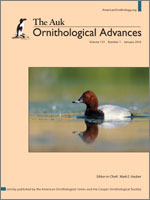The study of phenology has received renewed interest in recent years, in large part due to concern over species' abilities to adapt to a changing climate. Nowhere is this more apparent than in the study of bird migration. Some bird species have adjusted their timing of migration along with climate change, whereas others have not, and an additional issue is that even those that adjust may not be able to do so quickly enough to keep up with phenological shifts in the resources upon which they depend. Such phenological “mismatches” are predicted to have negative fitness consequences for migratory birds (Visser et al. 1998). Phenological Synchrony and Bird Migration tackles these issues from a slightly new angle. While most research to date has been focused on phenology at stationary breeding or nonbreeding areas, this volume is focused almost entirely on stopover phenology. This is a major strength of the book, but it also creates some shortcomings, which I'll discuss below. Also novel is that the book is specific to North America, whereas much past research on migration phenology has taken place in Europe.
The book is divided into four sections. The first concerns conservation and management issues related to climate change and bird migration, including some theoretical models that describe how species and ecosystems are predicted to respond to projected climate change. Although somewhat dry, this section is highlighted by a chapter on the National Phenology Network's citizen-science program “Nature's Notebook,” a must-read for anyone who wants to know how the data generated by this network could be incorporated into their own research. I found the authors' argument for the value of phenological monitoring, over and above the more typical assessment of relatively static vegetation resources, especially compelling: Phenological monitoring of vegetation and other resources relevant to birds allows for a more mechanistic understanding of bird habitat selection and, thus, the potential drivers of changes in bird phenology.
The next section, “Migratory Connectivity,” includes two chapters that examine relationships between spring arrival phenology and weather experienced by birds on the wintering grounds. These studies add to a growing body of research demonstrating that the conditions experienced by migratory birds across the phases of their annual cycle can influence their performance, including arrival timing, during subsequent phases. As such, this section might have been more appropriately titled “Carryover Effects of Weather” rather than “Migratory Connectivity,” which has more to do with the degree to which individuals from specific breeding populations are connected to specific wintering populations and vice versa (Webster et al. 2002). In any case, the section serves to showcase, once again, the potential utility of citizen science for informing phenology studies, as demonstrated by a study that makes use of a large dataset from Project FeederWatch to examine variation in arrival of short-distance migrants in relation to winter weather.
The final two sections, “Spring Migration” and “Fall Migration,” are arguably the meat of the book: seven chapters that aim to understand variation in the phenology of birds and their resources (and potential mismatches between the two) at stopover areas. They include studies of poorly understood phenomena such as trophic cascades and the (mal)adaptive significance of phenological synchrony, in addition to the more rarely studied period of fall migration. However, these sections are where the shortcomings inherent in the relatively young field of stopover phenology play out, because many of the chapters include data collected over only two or three seasons at only a handful of study sites. Thus, it may be difficult to generalize the findings to the context of long-term phenological changes over large spatial scales. This is not to say that these chapters are not useful—on the contrary, they provide a necessary framework for future work. The exception to the problem of small sample size is the final chapter, which provides an in-depth study of fall migration phenology of 37 landbird species over 44 years at the Manomet Center for Conservation Sciences. Interestingly, the findings highlight the significant variability in the ways that different species are responding to a changing climate, serving to underscore the importance of understanding this variation if we are to achieve species-specific conservation goals.
Overall, Phenological Synchrony and Bird Migration would make a useful contribution to the personal libraries of researchers and graduate students who study bird migration and resource phenology in North America. In fact, the book should be especially valuable for new graduate students who are developing their own projects and want to get a feel for what has been done and where the gaps remain. Thus, the major contribution of this book is likely to be the foundation it will provide for future research into climate change, phenology, and bird migration.





